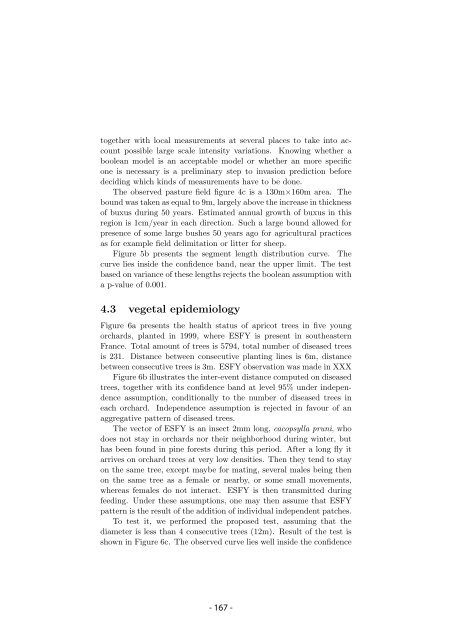Ecole Nationale Supérieure Agronomique de Montpellier ... - CIAM
Ecole Nationale Supérieure Agronomique de Montpellier ... - CIAM
Ecole Nationale Supérieure Agronomique de Montpellier ... - CIAM
Create successful ePaper yourself
Turn your PDF publications into a flip-book with our unique Google optimized e-Paper software.
together with local measurements at several places to take into account<br />
possible large scale intensity variations. Knowing whether a<br />
boolean mo<strong>de</strong>l is an acceptable mo<strong>de</strong>l or whether an more specific<br />
one is necessary is a preliminary step to invasion prediction before<br />
<strong>de</strong>ciding which kinds of measurements have to be done.<br />
The observed pasture field figure 4c is a 130m×160m area. The<br />
bound was taken as equal to 9m, largely above the increase in thickness<br />
of buxus during 50 years. Estimated annual growth of buxus in this<br />
region is 1cm/year in each direction. Such a large bound allowed for<br />
presence of some large bushes 50 years ago for agricultural practices<br />
as for example field <strong>de</strong>limitation or litter for sheep.<br />
Figure 5b presents the segment length distribution curve. The<br />
curve lies insi<strong>de</strong> the confi<strong>de</strong>nce band, near the upper limit. The test<br />
based on variance of these lengths rejects the boolean assumption with<br />
a p-value of 0.001.<br />
4.3 vegetal epi<strong>de</strong>miology<br />
Figure 6a presents the health status of apricot trees in five young<br />
orchards, planted in 1999, where ESFY is present in southeastern<br />
France. Total amount of trees is 5794, total number of diseased trees<br />
is 231. Distance between consecutive planting lines is 6m, distance<br />
between consecutive trees is 3m. ESFY observation was ma<strong>de</strong> in XXX<br />
Figure 6b illustrates the inter-event distance computed on diseased<br />
trees, together with its confi<strong>de</strong>nce band at level 95% un<strong>de</strong>r in<strong>de</strong>pen<strong>de</strong>nce<br />
assumption, conditionally to the number of diseased trees in<br />
each orchard. In<strong>de</strong>pen<strong>de</strong>nce assumption is rejected in favour of an<br />
aggregative pattern of diseased trees.<br />
The vector of ESFY is an insect 2mm long, cacopsylla pruni, who<br />
does not stay in orchards nor their neighborhood during winter, but<br />
has been found in pine forests during this period. After a long fly it<br />
arrives on orchard trees at very low <strong>de</strong>nsities. Then they tend to stay<br />
on the same tree, except maybe for mating, several males being then<br />
on the same tree as a female or nearby, or some small movements,<br />
whereas females do not interact. ESFY is then transmitted during<br />
feeding. Un<strong>de</strong>r these assumptions, one may then assume that ESFY<br />
pattern is the result of the addition of individual in<strong>de</strong>pen<strong>de</strong>nt patches.<br />
To test it, we performed the proposed test, assuming that the<br />
diameter is less than 4 consecutive trees (12m). Result of the test is<br />
shown in Figure 6c. The observed curve lies well insi<strong>de</strong> the confi<strong>de</strong>nce



